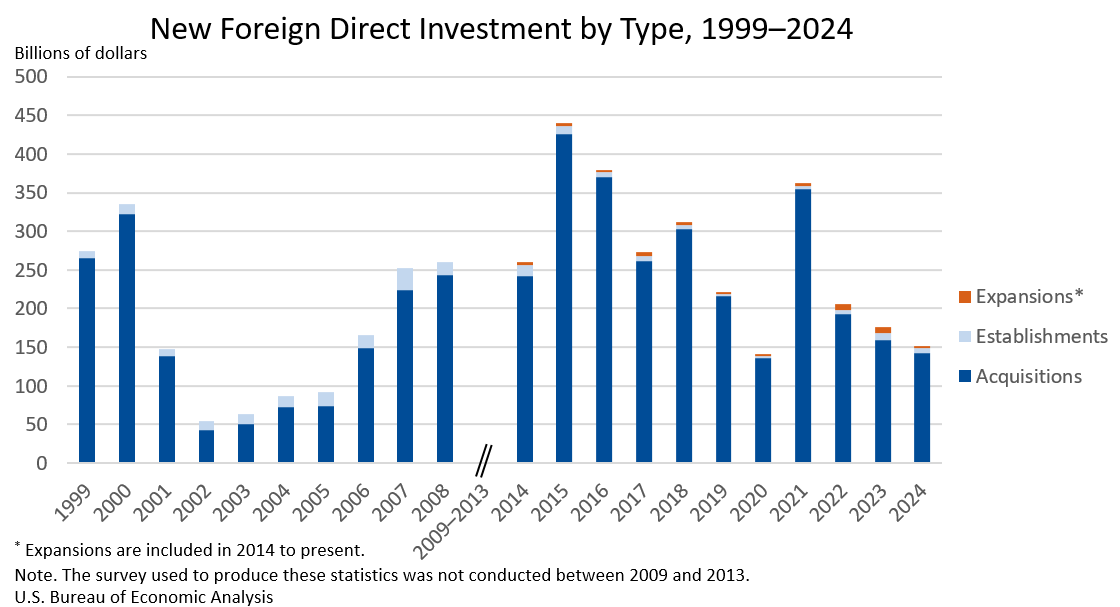Bureau of Economic Analysis
New Foreign Direct Investment in the United States, 2024
Expenditures by foreign direct investors to acquire, establish, or expand U.S. businesses totaled $151.0 billion in 2024, according to preliminary statistics released today by the U.S. Bureau of Economic Analysis. Expenditures decreased $24.9 billion, or 14.2 percent, from $176.0 billion (revised) in 2023 and were below the annual average of $277.2 billion for 2014–2023. As in previous years, acquisitions of existing U.S. businesses accounted for most of the expenditures.
Principal Federal Economic Indicators
Noteworthy
- 2025 News Release Schedule
- Innovation at BEA
- 2025 Annual Updates
- New! Services Trade Data for More Countries
- Data Tool: Trade in Value Added
- Distribution of State Personal Income
- Updated: RIMS II Regional Multipliers
- Arts and Culture
- Space Economy
- FDI Now in State BEARFACTS
- Quick Guide: Price Indexes
The Latest
Gross Domestic Product, (Third Estimate), GDP by Industry, and Corporate Profits (Revised), 2nd Quarter 2021
Real gross domestic product (GDP) increased at an annual rate of 6.7 percent in the second quarter of 2021, reflecting the continued economic recovery, reopening of establishments, and continued government response related to the COVID-19 pandemic. The increase was revised up 0.1 percentage point from the "second" estimate released in August. In the second quarter, government assistance payments in the form of loans to businesses and…
U.S. International Investment Position, Second Quarter 2021
The U.S. net international investment position, the difference between U.S. residents’ foreign financial assets and liabilities, was –$15.42 trillion at the end of the second quarter of 2021, according to statistics released by the U.S. Bureau of Economic Analysis (BEA). Assets totaled $34.20 trillion and liabilities were $49.62 trillion. At the end of the first quarter, the net investment position was –$14.30 trillion.
U.S. International Investment Position Second Quarter 2021
The U.S. net international investment position, the difference between U.S. residents’ foreign financial assets and liabilities, was –$15.42 trillion at the end of the second quarter of 2021, according to statistics released by the U.S. Bureau of Economic Analysis. Assets totaled $34.20 trillion and liabilities were $49.62 trillion. At the end of the first quarter, the net investment position was –$14.30 trillion.
Gross Domestic Product for Puerto Rico, 2019
Real gross domestic product (GDP) increased 0.3 percent in 2019 after decreasing 2.4 percent in 2018, according to estimates released today by the Bureau of Economic Analysis (BEA). The statistics released today are BEA’s first official release of GDP for Puerto Rico. The release includes updated estimates for 2012 to 2018 that incorporate new and additional source data and methodology improvements to the prototype GDP statistics that were…
Gross Domestic Product for Puerto Rico, 2019
Real gross domestic product increased 0.3 percent in 2019 after decreasing 2.4 percent in 2018, according to estimates released today by the Bureau of Economic Analysis. The statistics released today are BEA’s first official release of GDP for Puerto Rico. The release includes updated estimates for 2012 to 2018 that incorporate new and additional source data and methodology improvements to the prototype GDP statistics that were released in…
Personal Income by State, 2nd Quarter 2021
State personal income decreased 21.8 percent at an annual rate in the second quarter of 2021 after increasing 56.9 percent in the first quarter. In the second quarter of 2021, the decrease in transfer receipts was the leading contributor to personal income declines in all 50 states and the District of Columbia. The percent change in personal income across all states ranged from -10.1 percent in the District of Columbia to -34.0 percent in West…
Personal Income by State, 2nd Quarter 2021
State personal income decreased 21.8 percent at an annual rate in the second quarter of 2021 after increasing 56.9 percent in the first quarter. In the second quarter of 2021, the decrease in transfer receipts was the leading contributor to personal income declines in all 50 states and the District of Columbia. The percent change in personal income across all states ranged from –10.1 percent in the District of Columbia to –34.0 percent in…
U.S. International Transactions, Second Quarter 2021
The U.S. current account deficit widened by $0.9 billion, or 0.5 percent, to $190.3 billion in the second quarter of 2021, according to statistics from the U.S. Bureau of Economic Analysis. The revised first quarter deficit was $189.4 billion. The second quarter deficit was 3.3 percent of current dollar gross domestic product, down from 3.4 percent in the first quarter.
U.S. Current Account Deficit Widens in Second Quarter 2021
The U.S. current account deficit, which reflects the combined balances on trade in goods and services and income flows between U.S. residents and residents of other countries, widened by $0.9 billion, or 0.5 percent, to $190.3 billion in the second quarter of 2021. The widening mainly reflected reduced surpluses on services and on primary income that were mostly offset by a reduced deficit on secondary income. The second quarter deficit was 3…
July 2021 Trade Gap is $70.1 Billion
The U.S. monthly international trade deficit decreased in July 2021 according to the U.S. Bureau of Economic Analysis and the U.S. Census Bureau. The deficit decreased from $73.2 billion in June (revised) to $70.1 billion in July, as exports increased and imports decreased. The previously published June deficit was $75.7 billion. The goods deficit decreased$5.5 billion in July to $87.7 billion. The services surplus decreased $2.4 billion in…




